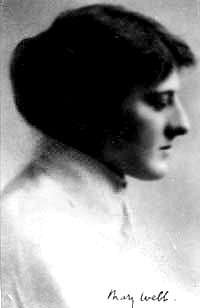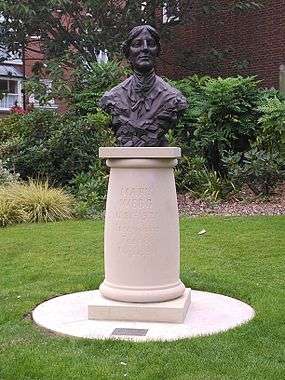Mary Webb

Mary Webb (25 March 1881 – 8 October 1927) was an English romantic novelist and poet of the early 20th century, whose work is set chiefly in the Shropshire countryside and among Shropshire characters and people which she knew. Her novels have been successfully dramatized, most notably the film Gone to Earth in 1950 by Michael Powell and Emeric Pressburger. They inspired the famous parody Cold Comfort Farm.
Life
She was born Mary Meredith in 1881 at Leighton Lodge in the Shropshire village of Leighton,[1] 8 miles (13 km) southeast of Shrewsbury. Her father, George Edward Meredith, a private schoolteacher,[2] inspired his daughter with his own love of literature and the local countryside. On her mother's side, Sarah Alice, she was descended from a family related to Sir Walter Scott. Mary explored the countryside around her childhood home, and developed a sense of detailed observation and description, of both people and places, which later infused her poetry and prose.
At the age of one year, she moved with her parents to Much Wenlock, where they lived at a house called The Grange outside the town. Mary was taught by her father then sent to a finishing school for girls at Southport in 1895.[2]
Her parents moved the family again in Shropshire, north to Stanton upon Hine Heath in 1896, before settling at Meole Brace, now on the outskirts of Shrewsbury, in 1902.[2]
At the age of 20, she developed symptoms of Graves' disease, a thyroid disorder (which resulted in bulging protuberant eyes and throat goitre), which caused ill health throughout her life and probably contributed to her early death. This affliction resulted in her being empathic with the suffering, and finds its fictional counterpart in the disfiguring harelip of Prue Sarn, the heroine of Precious Bane.
Her first published writing was a five verse poem, written on hearing news of the Shrewsbury rail accident in October 1907. Her brother, Kenneth Meredith, so liked the paper and thought it potentially comforting for those affected by the disaster that, without her knowledge, he took it to the newspaper offices of the Shrewsbury Chronicle, who printed the poem anonymously. Mary, who usually burnt her early poems, was appalled before hearing the newspaper received appreciative letters from its readers.[3]
In 1912, she married, at Meole Brace's Holy Trinity parish church, Henry Bertram Law Webb, a teacher who at first supported her literary interests. They lived for a time in Weston-super-Mare, before moving back to Mary's beloved Shropshire where they worked as market gardeners until Henry secured a job as a teacher at the Priory School for boys in Shrewsbury.
The couple lived briefly in Rose Cottage near the village of Pontesbury between the years 1914 and 1916, during which time she wrote The Golden Arrow.[4] Her time in the village was commemorated in 1957 by the opening of the Mary Webb School.[5]
The publication of The Golden Arrow in 1917 enabled them to move to Lyth Hill, Bayston Hill a place Mary loved, buying a plot of land and building Spring Cottage.
In 1921, they bought a second property in London hoping that she would be able to achieve greater literary recognition. This, however, did not happen. By 1927, she was suffering increasingly bad health, her marriage was failing, and she returned to Spring Cottage alone. She died at St Leonards on Sea, aged 46. She was buried in Shrewsbury, at the General Cemetery in Longden Road.[6]
Her writing in general was reviewed as notable for poetic descriptions of nature. Another aspect throughout her work was a close and fatalistic view on human psychology.[7]
She won the Prix Femina Vie Heureuse for Precious Bane. After her death that Stanley Baldwin, then Britain's Prime Minister, brought about her commercial success through his approbation; at a Literary Fund dinner in 1928, Baldwin referred to her as a neglected genius. Consequently her collected works were republished in a standard edition by Jonathan Cape, becoming best sellers in the 1930s and running into many editions.[8]
Stella Gibbons's 1932 novel Cold Comfort Farm was a parody of Webb's work,[9] as well as of other "loam and lovechild" writers like Sheila Kaye-Smith and Mary E. Mann [10] and, further back, Thomas Hardy. In a 1966 Punch article, Gibbons observed:
The large agonised faces in Mary Webb's book annoyed me ... I did not believe people were any more despairing in Herefordshire [sic] than in Camden Town.
The museum at the Tourist Information Centre in Much Wenlock includes a lot of information on Mary Webb including a display of photographs of the filming of her novel Gone to Earth in 1950.
Her cottage on Lyth Hill (not open to the public) can still be seen. In September 2013, plans were submitted for its demolition.[11]
Three of Webb's novels have been reprinted in recent times by Virago.[7]
Works
| Library resources about Mary Webb |
| By Mary Webb |
|---|
- The Golden Arrow (July 1916). London : Constable.
- Gone to Earth (September 1917). London : Constable.
- The Spring of Joy; a little book of healing (October 1917). London : J. M. Dent.
- The House in Dormer Forest (July 1920). London : Hutchinson.
- Seven For A Secret; a love story (October 1922). London : Hutchinson.
- Precious Bane (July 1924). London : Jonathan Cape.
- Poems and the Spring of Joy (Essays and Poems) (1928). London : Jonathan Cape.
- Armour Wherein He Trusted: A Novel and Some Stories (1929). London : Jonathan Cape.
- A Mary Webb Anthology, edited by Henry B.L. Webb (1939). London : Jonathan Cape.
- Fifty-One Poems (1946). London : Jonathan Cape. With wood engravings by Joan Hassall
- The Essential Mary Webb, edited by Martin Armstrong (1949). London : Jonathan Cape.
- Mary Webb: Collected Prose and Poems, edited by Gladys Mary Coles (1977). Shrewsbury : Wildings.
- Selected Poems of Mary Webb, edited by Gladys Mary Coles (1981). Wirral : Headland
Dramatic adaptations
Gone to Earth is the story of Hazel Woodus, a child of nature who simply wants to be herself, living among the remote Shropshire hills of the Welsh Marches with her harpist coffin-building father. She is reluctantly drawn into the world of romantic human relationships through her great beauty, marrying a local church minister, but also becomes the object of the local fox-hunting squire's obsessive love. Hazel is chased over the edge of a quarry trying to save her beloved pet fox from the local hunt. The title, of course, is the hutsman's cry denoting that the fox had escaped into its den. Gone to Earth was filmed in 1950 by Michael Powell and Emeric Pressburger, starring Jennifer Jones as Hazel Woodus. However, it was later re-edited, shortened and retitled for its American release, and fell into relative obscurity. In 1985, the full 110-minute restored version was released by the National Film Archive, to critical acclaim.[12]
Precious Bane is set in the years after the Battle of Waterloo, and tells the story of Prue Sarn, disfigured by a harelip which her superstitious neighbours regard as a sign that she is a witch, and how she falls in love with a visiting weaver, Kester Woodseaves. It was first produced as a six-part BBC television drama series in 1957, starring Patrick Troughton and Daphne Slater.[13] It was then adapted for French television (ORTF) in 1968 by director Claude Santelli, with Dominique Labourier as Prue, Josep Maria Flotats as Gedeon and Pierre Vaneck as Kester.[14] The title was Sarn, after the French title of the novel. The most recent adaptation was as a television play by the BBC in 1989, with Janet McTeer as Prue, Clive Owen as her brother Gideon, and John Bowe as Kester.
Memorials
A monumental bust of Mary Webb, commissioned by the Mary Webb Society, was unveiled in the grounds of Shrewsbury Library on 9 July 2016.[15]

Notes
- ↑ Dickins, Gordon (1987). An Illustrated Literary Guide to Shropshire. Shropshire Libraries. pp. 74, 99. ISBN 0-903802-37-6.
- 1 2 3 Dickins, Gordon (1987). An Illustrated Literary Guide to Shropshire. p. 74.
- ↑ Francis, Peter (2006). A Matter of Life and Death - The Secrets of Shrewsbury Cemetery. Logaston Press. p. 41. ISBN 1-904396-58-5.
- ↑ Mary Coles, Gladys (1990). Mary Webb. Stroud: Seren Books. ISBN 1-85411-034-9.
- ↑ "About us". The Mary Webb School and Science College. Retrieved 2007-10-17.
- ↑ Francis, Peter (2006). A Matter of Life and Death, The Secrets of Shrewsbury Cemetery. Logaston Press. p. 55. ISBN 1-904396-58-5.
- 1 2 "Mary Webb: brighter and better than Thomas Hardy". The Guardian. 10 March 2009. Retrieved 16 July 2015.
- ↑ "Biography". The Mary Webb Society. Retrieved 16 July 2015.
- ↑ Literary Encyclopedia: Cold Comfort Farm
- ↑ Hammill, Faye Cold Comfort Farm, D. H. Lawrence, and English Literary Culture Between the Wars, Modern Fiction Studies 47.4 (2001) 831-854
- ↑ "Anger at demolition plan for writer's Shrewsbury home". Shropshire Star. 16 October 2013. Retrieved 20 October 2013.
- ↑ "The Powell & Pressburger Pages". Retrieved 16 July 2015.
- ↑ "Obituaries: Daphne Slater". The Telegraph. Retrieved 16 July 2015.
- ↑ "Sarn (Film, 1968)". WorldCat. Retrieved 16 July 2015.
- ↑ "Literary legend's bust to be unveiled in park". Shropshire Star. 9 July 2016. p. 7.
References
- Barale, Michele Aina. Daughters and Lovers: The Life and Writing of Mary Webb. 1986
External links
- The Mary Webb Society
- Works by Mary Webb at Project Gutenberg
- Works by or about Mary Webb at Internet Archive
- Works by Mary Webb at LibriVox (public domain audiobooks)

- Gone to Earth by Mary Gladys Meredith Webb at Project Gutenberg
- Literary Heritage - West Midlands - profile and e-texts of all her novels